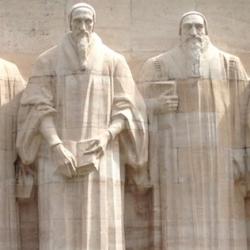During the 15th century, Boxley Abbey in Kent boasted a crucifix with a movable Jesus. It was able “to bow down and lifte up it selfe, to shake and stirre the handes and feete, to nod the head, to rolle the eies, to wag the chaps, to bende the browes, and finally to represent to the eie, both the proper motion of each member of the body, and also a lively, expresse, and significant shew of a well contented or displeased minde: byting the lippe, and gathering a frowning, forward, and disdainful face, when it would pretend offence: and shewing a most milde, amiable, and smyling cheere and countenance, when it woulde seeme to be well pleased” (quoted by Jessica Riskin, Restless Clock, 12). All this done by “stringes of haire.”
It was not alone. Europe was full of mechanical devils, “automaton angels,” mechanical reenactments of biblical events.
All this ended with the Reformation. As Riskin says, “The uncouth Bretzelmann of Strasbourg Cathedral was silenced along with many of his fellow organ automata, and, indeed, with many of the church organs themselves, which became emblematic of Catholic ritual. Henry VIII, in establishing the Anglican Church, banned mechanical statues from English churches. The grimacing Rood of Boxley Abbey gave its last performance in 1538, after being snatched from Boxley by Geoffrey Chamber as part of his commissioned defacement of the abbey. Chamber wrote to Thomas Cromwell that he had found in the Rood ‘certain engines and old wire, with old rotten sticks in the back, which caused the eyes to move and stir in the head thereof, ‘like unto a lively thing,’ and also, ‘the nether lip to move as though it should speak,’ which was not a little strange to him and others present” (Riskin, 23).
Riskin’s explanation of the theology behind this elimination is misleading—“the Reformers distinguished God from nature and spirit from matter” (22). Animated—soulish—machines confused matter and spirit, and so needed to be eliminated. Some of the Reformers distinguished spirit and matter, but no Reformer made this distinction as sharply or clumsily as Riskin. She suggests that the Reformation led to a “fundamentally transformed view of machines,” as “fraudulent heaps of inert parts” (24). Which seems a difficult thesis to sustain, considering Protestant role in early modern science and technology.
Regarding other effects of eliminating such mechanical devices, Riskin may be on more secure ground. These devices were playful, funny, and their destruction removed one source of delight from Protestant churches.













